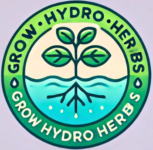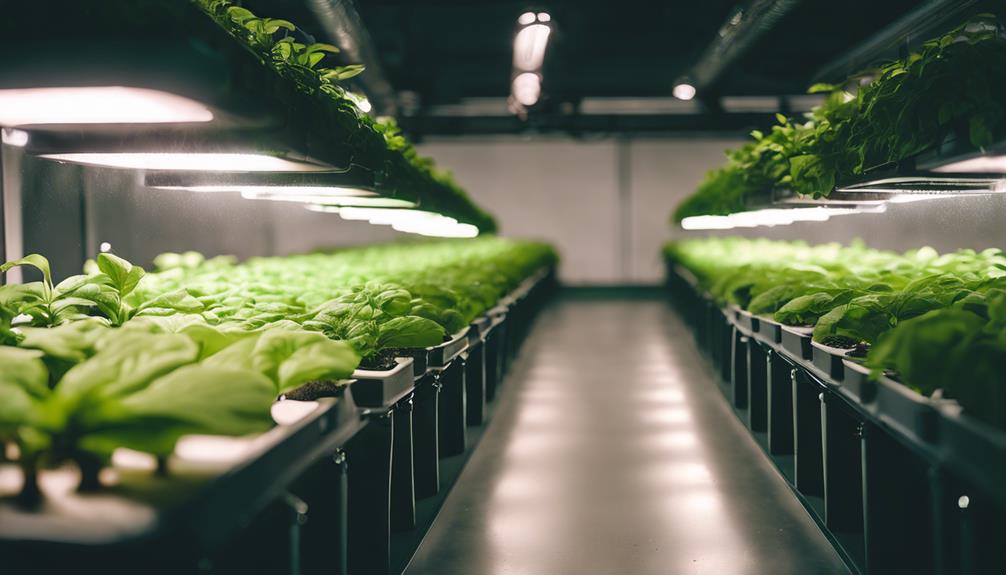Mastering Countertop Hydroponics: Avoid These 5 Common Pitfalls
Are you struggling to get the best results from your countertop hydroponic garden? Avoid these five common mistakes to ensure your plants thrive and produce bountiful harvests. Keep reading to learn how to create a healthier, more productive garden.
To guarantee success, steer clear of these common mistakes in your countertop hydroponic garden.
- Don’t ignore pH levels; maintain them between 5.5 and 6.5 for ideal nutrient availability.
- Use adequate lighting—aim for 12-16 hours a day with LED or fluorescent options.
- Select hydroponic-specific fertilizers to avoid clogging drains.
- Prioritize sanitation by regularly cleaning tools and surfaces to prevent pathogens.
- Commit to educating yourself through resources and community interactions.
Avoiding these errors sets you up for healthy plants and bountiful yields. Discover more essential tips for thriving hydroponic gardening.
Common Mistake #1: Ignoring Ph Levels
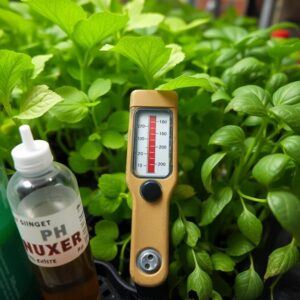
When I started, I assumed my pH levels would be awesome! After all, I used distilled water, avoiding the hard water we had that had a pH over 8! Distilled water has a pH of 7 since it has nothing in it, right?
Wrong.
Apparently, distilled water can absorb carbon dioxide and has a pH of around 5.5! I didn’t have anything more than pH strips so it kinda looked ok. Before I added the nutrients? And that made it worse!
pH levels play an essential role in the success of your countertop hydroponic garden. Maintaining these levels between 5.5 and 6.5 is vital for ensuring nutrient availability. Proper management of nutrient levels in water is essential for robust growth, preventing deficiencies or excess, as highlighted in the section on nutrient solution management.
If you ignore pH management, you risk nutrient lockout, leading to nutrient deficiencies that can stunt your plants’ growth or even cause their death. In a hydroponic system, daily monitoring with a quality pH meter is a must, as the health of all plants can deteriorate quickly with imbalanced pH.
It’s also important to regularly adjust pH levels, as factors like nutrient uptake and water quality can cause fluctuations over time. A common mistake many gardeners make is assuming pH levels will remain stable without intervention.
Proactive management is key to promoting healthy plant development. By staying vigilant and adjusting your nutrient solution when necessary, you can avoid widespread issues that compromise your garden’s success.
Don’t let neglect derail your hydroponic efforts. Embrace the responsibility of monitoring the levels, and you’ll foster a thriving environment for your plants.
Common Mistake #2: Inadequate Lighting Choices
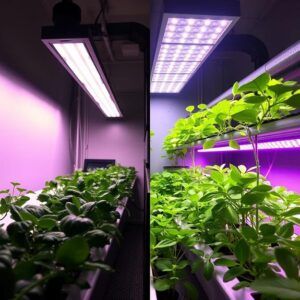
When it comes to countertop hydroponic gardening, inadequate lighting choices can greatly hinder your plants’ growth potential. Your plants require 12-16 hours of quality light daily to thrive, and choosing the right type of grow lights is vital. Excessive light duration can cause stress, while insufficient light leads to weak plants; therefore, finding a balance is essential.
Incandescent bulbs won’t cut it; they often lead to poor growth outcomes. Instead, opt for LED lights or fluorescent options, as they provide the necessary light spectrum and are more energy-efficient light requirements and duration.
It’s important to take into account light intensity, especially for different types of plants. Each plant species has specific light requirements, so make sure you’re meeting those needs.
Light height is another key factor—maintain a distance of 12 to 18 inches from the plants to guarantee they receive adequate intensity. If the light is too far away, you’ll notice stunted growth and reduced yields.
Note that this varies with the plant. For example, for basil plants, 4″ above the plant seems to be working.
From my experience. The kitchen tabletop kits are AWESOME to start with. But when you look at the lighting carefully? It doesn’t cover the whole growing surface evenly. My wife (who is about as detached from this as it gets) noticed something really simple; the plants in the back were growing two to three times faster than the ones in back. Why? Because the lights stopped half an inch from the front. Solution? Rotate the plants!
Regularly monitor both the duration and intensity of light your plants receive. Inadequate lighting can result in elongated stems and smaller leaves, clear indicators of poor growth conditions in your hydroponic garden.
Common Mistake #3: Using Incorrect Fertilizers

Inadequate lighting can severely impact plant growth, but using incorrect fertilizers can be just as detrimental. When you’re gardening hydroponically, conventional fertilizers just won’t cut it. They can clog drains and disrupt the delicate nutrient delivery system essential for thriving plants.
Instead, you should opt for hydroponic-specific fertilizers, which are specially formulated to cater to the unique needs of soil-less growing. These come in both liquid and granule forms, giving you the flexibility to match your hydroponic setup. Additionally, ensuring your plants receive adequate light exposure is essential for maximizing nutrient absorption and promoting healthy growth.
The manufacturer of my kitchen tabletop said that the plant nutrient solution worked for all plants and just gave a blanket recommendation of 5 ml of nutrient per liter of water. Well, the TDS and EC measurements are very high, meaning there is too much food in the water. Solution? Put everything in a separate tank. Balance the pH. Add a little nutrient solution. Measure, balance, add. Until its’ right for that plant.
It’s important to regularly test and adjust your nutrient solutions to prevent deficiencies or toxicities that could harm your plants. Remember, following the manufacturer’s instructions is critical to avoid over-fertilization. Using the wrong amounts can burn plant roots and stunt overall growth.
By using the right fertilizers and adhering to recommended guidelines, you can optimize plant health and yield. Embracing these practices not only nurtures your plants but also fosters a thriving, successful hydroponic community.
Common Mistake #4: Neglecting Sanitation Practices
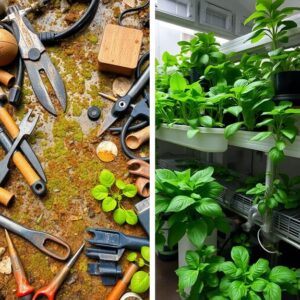
One of the most overlooked aspects of successful countertop hydroponic gardening is sanitation. Regular cleaning of all surfaces, tools, and containers helps prevent the buildup of harmful pathogens that can lead to plant diseases. By maintaining a clean environment, you not only enhance plant growth but also minimize the risk of infestations, making sanitation a key factor in your gardening success.
Sterilizing equipment like pumps and tubing is essential. A simple bleach solution can effectively eliminate bacteria and fungi that could compromise your plants’ health.
Don’t forget about proper disposal of plant waste, such as dead leaves or roots. Leaving this material can attract pests and create a breeding ground for diseases.
Implementing a routine sanitation schedule is vital. It greatly reduces the likelihood of health issues in your hydroponic garden, leading to a more productive and thriving setup.
Common Mistake #5: Failing to Educate Yourself

Many aspiring countertop hydroponic gardeners underestimate the importance of proper education in this complex field. With extensive resources available, including college courses and over a century of published literature, you can greatly improve your gardening skills.
Understanding the different types of plants suitable for hydroponics, like Fresh Herbs, is essential for success in your indoor garden.
Engaging with online articles, forums, and communities keeps you updated on best practices and troubleshooting techniques.
Don’t overlook the value of regular workshops; they enhance practical skills and provide hands-on experience in managing hydroponic systems effectively. Utilizing educational materials, such as guides and video courses, equips you with critical knowledge about nutrient management, pH levels, and system setup, helping you avoid costly mistakes.
Networking with experienced hydroponic gardeners can also foster knowledge sharing, leading to improved success rates in achieving thriving crops.
Cultivate Success by Avoiding These Countertop Hydroponic Gardening Mistakes
By steering clear of these common mistakes, you’ll cultivate a thriving countertop hydroponic garden that flourishes like a well-tended oasis. Keeping an eye on pH levels, choosing the right lighting, using proper fertilizers, maintaining sanitation, and committing to continuous learning are the roots of your success. With a little diligence, your plants will reach for the sky, transforming your space into a vibrant tapestry of greens and colors that nourish both body and soul.
Want to ensure your countertop hydroponic garden thrives? Start by addressing these common mistakes today! By monitoring pH levels, choosing the right lighting, and using the proper fertilizers, you’ll set your plants up for success. Don’t forget to share your gardening journey with us in the comments below, and check out our recommended resources for additional tips!
Questions? We Have Answers.
Get answers to a list of the most Frequently Asked Questions.
